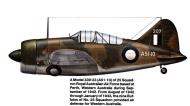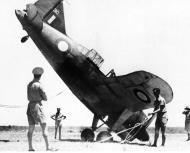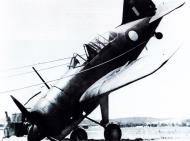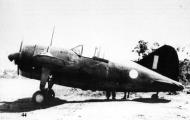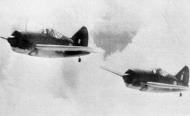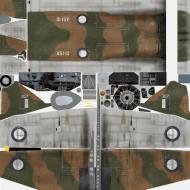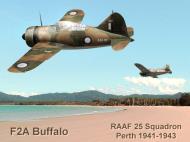Brewster Buffalo MkI RAAF 25Sqn A51-10 Perth Australia 1941
Brewster Buffalo MkI RAAF 25Sqn A51-13 Perth Australia 1941
Brewster Buffalo MkI RAAF 25Sqn A51-7 Perth Australia 1941
History of No. 243 Squadron.
Motto: " Swift in pursuit "
Badge: A seahorse holding a sword erectNo 243 Squadron was formed in August 1918 from Nos 414 and 415 Flights of the seaplane station at Cherbourg which had been functioning as an out-station of Calshot while part of the Royal Naval Air Service. Its seaplanes carried out anti-submarine patrols off the French coast and around the Channel Islands until the end of the war and it disbanded on 15 March 1919.
On 12 March 1941, No.243 reformed at Kallang as a fighter squadron for the defence of Singapore. The shortcomings of its Buffaloes were soon apparent and when Japanese fighters came within range, the squadron suffered heavy loses and by the end of January 1942 was operating its surviving aircraft as part of a mixed force, the other Buffalo squadrons being in a similar state. Its identity was gradually lost to the evacuation of redundant personnel and by the time all fighters were withdrawn from the Singapore airfields, it no longer existed as a unit, having been disbanded on 20 January 1942.
On 1 June 1942, No.243 reformed at Outston, taking over No.242 Squadron's Spitfires and became operational on the 12th. After defensive duties, it turned its aircraft over to No.232 Squadron at the end of September and in November sailed for North Africa, where it became operational again with Spitfires in Algeria in January 1943. For the rest of the Tunisian campaign, it flew sweeps and provided escorts for day bombers attacking enemy bases and transport and in June moved to Malta for similar missions over Sicily. A few days after the Allied landings there, No.243 moved into the beachhead, repeating this in September after the Salerno landings. In December 1943, it moved to the Levant and after fully converting to Spitfire IXs left for Corsica in April 1944. Escort missions and ground attack sweeps were flown over northern Italy and southern France and cover provivded for the Allied landings on the French Riviera in August before the squadron was again disbanded on 31 October 1944.
No.243 reformed on 15 December 1944 at Morecambe, two days before embarking for Canada where it began training with Dakotas. In January 1945, these began moving across the Pacific to Audtralia, where communications flights began between British bases in the South West Pacific area, mainly to British Pacific Fleet bases. By the end of the war the squadron was flying scheduled services and extended these to Hong Kong on its surrender. A large proportion of the squadron personnel was Australian and they were demobilised locally when No.243 disbanded on 15 April 1946.
Grub Street
Buffaloes over Singapore
RAF, RAAF, RNZAF and Dutch Brewster fighters in action over Malaya and The East Indies 1941-42
Brian Cull with Paul Sortehaug and Mark HaseldenReviewed by Tony Oliver
ISBN: 1-904010-32-6 Hdbk 253pp 70 b/w photographs 2pages maps 5 Appendices, Bibliography and index of personnel
The B-339 Buffalo received much criticsm during its brief service with the RAF/ Commonwealth forces. Much of this condemnation was richly deserved whilst some of it wasn't. Considered unfit for service with the RAF in the ETO, the majority of the 170 Brewster fighters including diverted machines from a cancelled Belgian AF order, were crated and shipped to the Far East. It was believed by the Air Staff that there they would be more than a match for the opposition.
An opposition that was to prove far from the colonial idea of an inferior second rate air force.
But this was just the first in a catalogue of errors and inept leadership that led to the rout of Commonwealth forces from the Malay Peninsula and the East Indies resulting in the tragedy that was the fall of Singapore.
Brian Cull's book follows a similar format to his other titles all of which detail the fortunes of the aircraft and units involved in some of the lesser known and documented historic air battles of the 20th Century.
His previous titles 'Bloody Shambles' Vol's 1and 2 with Chris Shores and Yasuho Izawa (Grub Street) are an intense account of the Far East air war in the early years. This title is a logical addition and is a very thorough and detailed perspective. This is remarkable when its considered that the tide of war in this region and the swiftness of the Japanese assault on Malaya, must have left little time for accurate record keeping. Indeed reading the accounts, which are liberally spread throughout the book taken from personal diaries, squadron diaries and official records, it's obvious that the author spared no effort in thoroughly researching this title.
The title might suggest that its a reference work for Buffalo modellers, which it is not but it does have 20 pages of original black and white photographs, many of which provide clear reference for RAF and the few Dutch Buffalo schemes. There are also references in the text to specific aircraft and the elusive night-fighter Buffaloes 'Black Bess' and 'Black Beauty'. However if like me you enjoy reading and researching the historical aspect behind the mechanical subject, then this title is totally absorbing.
My one criticism would be a lack of reference maps throughout the book. It is difficult to get a mental image of the terrain and the geography of the Malay Peninsula and the location of the airfields in a strategic context, and having to flick to the back of the book for reference spoils the flow of reading somewhat.
But that said, the text brings to life via the recollections and diary anecdotes, a world and lifestyle gone forever. It also illustrates how the colonial existence among the rubber plantations was maintained right up to the point at which the Japanese were knocking at the door, indeed one of the senior officers was more concerned about saving his stamp collection than for the welfare of his ground staff!
It also dispels any myth of aerial chivalry at a time when the Battle of Britain had recently ended and along with it the popular notion of giving the other chap a fighting chance. Numerous accounts both detailed and bloody of the effects of war and deeds carried out in the name of the Imperial Japanese Emperor reinforce the image of a more barbaric campaign being fought over this outpost of the British Empire. Accounts of pilots machine-gunned in their 'chutes and strafed whilst escaping from a wreck are commonplace, as are the bombing of non-strategic targets such as residential areas and villages. I'm not saying that we should be surprised by this, as the war in the Far East is well documented in its cruelty but the accounts are vivid and original and make the book all the more real for this.
That the Commonwealth pilots were courageous in the face of overwhelming superiority of numbers and equipment goes without saying, but that courage is well illustrated here by some truly astonishing accounts of aerial conflict. Not only contending with an enemy numerically, tactically and technologically superior, but also having to cope with an aircraft so outmoded as a fighting aircraft that it couldn't be climbed on full power for fear of overheating must have made the pilots wonder whether the new day would be their last. However amongst this life went on and for the ones who made it back in one piece, or more often with pieces missing, its apparent that a damn good 'piss up' was the order of the day.
quote: "So our second engagement with the enemy was not so successful. Outnumbered ten to one, and taken completely by surprise, the boys had no chance. One lesson we have to learn is never to leave the ground when the enemy is directly overhead. Seven weary pilots went into town at night and took quarters at the 'Station Hotel' and the 'Majestic'. After a good feed and a few beers, all felt slightly better but all considerably shaken by our introduction to the real thing".
If you want to read something a bit different from the tales of the 8th AF and the Jadgdwaffe or the 'gentlemanly' conduct of the Battle of Britain and really get an insight into flying life in the Far East in the early Forties, then this would be a good place to start.
To finish here's some views on life as a Buffalo pilot from Sgt.Geoff Fisken DFC RNZAF 243Sqn
Reflections: The Buffalo:
"It was a real ladies plane, a beautiful plane to fly. Anybody could fly them. We flew them with the hoods open, it was cooler and there was no wind blast"
"I flew a Hurricane MkIIb, I didn't think it was as good as the Buffalo".
Lack of warning:
"The British always said they'd (the Japs) never come from the North. That's why all the guns pointed out to sea."
"We never got any warning, nine times out of ten, by the time we took off, they were over us."
Japanese Pilots:
"They were very good, they were very, very good over Singapore.
"You could only get away in a Buffalo by diving straight down, they never followed you down."
"Their aircraft were so much lighter, they were much more manoeuvrable, they had us beat."
"To dogfight with a Jap was committing suicide, it was impossible."(the Ki-43 Hayabusa could turn inside a Buffalo with ease)
"The only way of getting a victory, was by bashing in, get a three second burst and then get out of it."
And finally fifty one year old Group Cpt. Rice; he was made prisoner after Singapore and did not survive his captivity. Sqn Ldr Howell forwarded Rice's report on the actions of 243Sqn to the Air Ministry on his release.
"Up against superior aircraft, and outnumbered 6 to 1, they showed a spirit equal to if not greater, than that of the pilots in the Battle of Britain (Rice served in the BoB). With practically no hope of rescue if shot down, they pursued the enemy and succeeded in shooting down in excess of 60 aircraft. The ground crews did all in their power to keep the aircraft in the air, under very trying and exhausting conditions. Great work was done by pilots and crews under difficulties"
Brian Cull's follow up to this title will be Hurricanes over Singapore.
Recommended historical reading.
Commonwealth Buffalo squadrons in Southeast Asia
When the war broke out, the British had four Buffalo squadrons at Singapore and in Northern Malaya. Another was stationed in Burma.
The pilots included only 15 who actually served in the Royal Air Force. The others were officers or (the majority) sergeant-pilots from Australia and New Zealand. Altogether, the Buffalo pilots numbered 118, of whom 28 were killed and another was captured--25 percent lost in less than two months. Several others were badly injured.
U.S. Army equivalent ranks: squadron leader = major, flight lieutenant = captain, flying officer = 1st Lt, pilot officer = 2nd Lt
RAAF 21 City of Melbourne Squadron
The "City of Melbourne" squadron had 12 Buffaloes at Sungei Patani, Northern Malaya, on 8 Dec 1941. 8 destroyed on the ground that day, and the squadron withdrew to Butterworth. 2 more Buffs were shot down on 9 Dec in the first air-to-air combat for RAF fighters in the Pacific. The squadron was then withdrawn to Ipoh and merged with 453 Sq under S/L Harper (see below). Squadron embarked for Australia 27 Jan.
Sqn Ldr W F Allshorn RAAF
Flt Lt F H Williams RAAF
Flt Lt Max White RAAF (shot down 14 Dec; killed)
Flt Lt J R Kinninmont RAAF (crashed 15 Dec; claimed a scout and a Ki-43 19 Jan)
Flg Off G M Sheppard RAAF
Flg Off Bob Kirkman RAAF (claimed a Ki-51 19 Jan)
Flg Off C R McKenny RAAF (shot down 9 Dec; injured)
Flg Off H V Montefiore RAAF (shot down 9 Dec)
Flg Off D M Sproule RAAF
Flg Off J B Hooper RAAF (crashed 15 Dec)
Flg Off B Hood RAAF
Flg Off R H Wallace RAAF (crashed after midair collison 12 Jan; injured)
Sgt Henry Parsons RAAF (shot down 19 Jan; killed)
Sgt Norman Chapman RAAF (shot down 18 Jan; killed)
Sgt G Harrison RAAF (crashed after midair collison 12 Jan)RAF 453 Squadron
18 Buffaloes and 1 Tiger Moth at Kallang, Singapore. 16 Buffs were sent north to Ipoh on 13 Dec, and the squadron earned the first solid air-to-air claim for a Buffalo that day, though the station commander and another pilot were killed when they crashed out of fuel. The newly appointed station commander, Wing Cdr L J Neale RAF, crashed 13 Dec and was injured. Got new a/c and withdrew to Kuala Lumpur, southern Malay, 19 Dec. First major air-to-air combat with the 64th Sentai on 22 Dec, 12 Buffs vs 18 Nakajima Ki-43 Hayabusas. With 3 a/c remaining, withdrew to Singapore island and got more aircraft, with the merged 21/453 Sq having 16 Buffaloes on 25 Dec. The Japanese by this time were flying from British airfields in Northern Malaya. With 4 Buffs remaining on 24 Jan, this was the only Buffalo squadron still functioning at the end of that month. At least 7 Buffs were flown out to Dutch Indies first week of February, and another (evidently the last) on 11 Feb.
Sqn Ldr Harper W H Harper RAF
Flt Lt Tim Vigors RAF DFC (shot down 13 Dec; injured)
Flg Lt R D Vanderfield RAAF, flight leader (claimed 2 Ki-48s on 13 Dec; claimed a bomber 15 Jan; claimed a Ki-51 19 Jan)
Flt Lt B A Grace, RAAF flight leader
Flg Off F Leigh Bowes RAAF (claimed a bomber 15 Jan)
Plt Off G L Angus RAAF (crashed 13 Dec)
Plt Off D R L Brown RNZAF, on attachment from 243 Sq (crashed 13 Dec; killed)
Plt Off R W Drury RAAF (crashed 22 Dec; killed)
Plt Off T W Livesey RAAF (crashed 13 Dec; injured; crashed 22 Dec)
Sgt J Austrain KC
Sgt Harry Griffiths RAAF (crashed on patrol 3 Jan; injured)
Sgt M N Read RAAF (claimed a Ki-51 on 13 Dec; shot down 22 Dec; killed)
Sgt S G Scrimgeour RAAF (shot down 22 Dec)
Sgt V A Collyer RAAF (claimed a Ki-51 on 13 Dec)
Sgt W R Halliday RAAF
Sgt A W B Clare RAAF (claimed a Ki-43 17 Jan)
Sgt Keith Gorringe RAAF (claimed a Ki-51 19 Jan; crashed 29 Jan)
Sgt R R Oelrich RAAF (shot down 13 Dec; killed)
Sgt E A Peterson RAAF (shot down 22 Dec; killed)
Sgt G R Board RAAF (crashed 18 Dec; shot down 22 Dec)
Sgt J Summerton RAAF
Sgt K R Leys RAAF (shot down 21 Dec)
Sgt M B O'Mara RAAF
Sgt Geoff Seagoe RAAF (shot down 1 Feb)RAF 243 Squadron
15 Buffaloes at Kallang, Singapore; 2 at Kota Bharu, Northern Malaya. On 12 Dec, 4 Buffs were flown up to Ipoh and attached to 21 Sq. On 25 Dec the squadron had 15 Buffs on strength. After a long convoy escort flight over water on 2 Jan, Sgt Weber wrote in his diary: "My word, when one is so far away from land it is gratifying to recall the reliability record of the Buff's engine." The squadron lost 7 Buffs to accidents in the first week of January. Only 2 Buffs remaining on 23 Jan. Squadron disbanded 27 Jan, with planes and pilots going to 453 Sq.
Sqn Ldr Frank Howell RAF, DFC (claimed a Ki-27 16 Jan)
Flt Lt Mowbray Garden RAF (claimed a Ki-43 13 Jan; shared a Zero 16 Jan)
Flt Lt Ron Bows RAF, flight leader
Flg Off M H Holder RAF
Plt Off E A Pevreal RAAF
Plt Off Gordon Bonham RNZAF (crashed on patrol 2 Jan; wounded 18 Jan)
Plt Off T B Marra RNZAF (claimed a Ki-27 16 Jan)
Plt Off J M Cranstone RNZAF
Plt Off R S Shield RNZAF (killed in takeoff collision 5 Jan)
Sgt Rex Weber RNZAF (shared a Zero 16 Jan; crashed 4 Feb from battle damage)
Sgt Bert Wipiti RNZAF (shared claim on a Ki-46 10 Jan; claimed a Ki-43 21 Jan; claimed a bomber 22 Jan)
Sgt Max Greenslade RNZAF (shot down 23 Jan)
Sgt Charlie Kronk RNZAF (shared claim on a Ki-46 10 Jan; claimed a Ki-48 20 Jan; crashed 1 Feb after damage by a Hurricane)
Sgt Reg Newman RNZAF (shot down 12 Jan; killed)
Sgt Russell Reynolds RNZAF (shot down 13 Jan)
Sgt C F Powell RAAF (crashed on patrol 2 Jan; injured)
Sgt Geoffry Fisken RNZAF (claimed a Ki-27 Nate, two G3M Nells, and three Zeros, Jan-Feb; leading Commonwealth fighter pilot against the Japanese)
Sgt Vic Arthur RNZAF (shot down 22 Jan; killed)
Sgt Noel Rankin RNZAF (shot down 12 Jan; killed)
Sgt P L Elliott RNZAF (killed in landing collision 5 Jan)
Sgt John Oliver RNZAF (missing in action 15 Jan)
Sgt Ginger Baldwin RAF (shot down 22 Jan; killed)RAF 488 Squadron
17 Buffaloes at Kallang, Singapore; 16 remaining on 25 Dec. This was the least-trained Buffalo squadron. The diarist wrote on 4 Jan: "The Squadron, thought not fully operational, has reached a high standard.... 90% of the pilots are quite at home in Buffaloes as far as throwing the machines around is concerned, but have had very little altitude flying [because] the Buffalo engine will not stand up to full-throttle climbs. We have had cases of engine loss of power through drop of oil pressure and excess oil temperature. The maximum height that can be reached is 25,000 feet." The squadron's first combat was on 12 Jan, with two Buffs lost and five damaged with no claims by the Kiwis. With only 2 Buffs remaining on 23 Jan, it handed them over to 243 Sq and was requipped with Hurricanes, and MacKenzie replaced Clouston as sqn ldr.
Sqn Ldr Wilf Clouston RAF, DFC
Flt Lt (later sqn ldr) J N MacKenzie RAF, DFC
Flt Lt J R Hutcheson RNZAF (shot down 13 Jan; shot down 17 Jan)
Plt Off Frank Oakden RNZAF (shot down 13 Jan)
Plt Off P D Gifford RNZAF
Plt Off J C Godstiff RNZAF (crashed 4 Jan; injured)
Plt Off Keith McAneny RNZAF (crashed 12 Jan; shot down 19 Jan; killed)
Plt Off H S Petit RNZAF
Plt Off G P White RNZAF
Plt Off Greville Hesketh RNZAF (shot down 15 Jan; killed)
Plt Off Bill Greenhalgh RNZAF
Plt Off Noel Sharp RNZAF (claimed a Ki-43 13 Jan; claimed a Zero 17 Jan; crashed 17 Jan)
Plt Off Frank Johnstone RNZAF (crashed 17 Jan)
Plt Off Ernie Cox RNZAF (shot down 17 Jan; killed)
Plt Off L R Farr RNZAF
Sgt W J N MacIntosh RNZAF
Sgt Ed Kuhn RNZAF (crashed 13 Jan; claimed a Ki-27 15 Jan)
Sgt Terry Honan RNZAF (shot down 12 Jan; injured)
Sgt Bob MacMillan RNZAF (shot down 12 Jan)
Sgt W R De Maus RNZAF
Sgt H J Meharry RNZAF
Sgt Don Clow RNZAF (crashed out of fuel 13 Jan)
Sgt Vic Meaclem RNZAF (crashed 12 Jan)
Sgt P E E Killick RNZAF (claimed a Zero 17 Jan)
Sgt J Burton RNZAF
Sgt C D Charters RNZAF (shot down 19 Jan; captured)
Sgt Alex Craig RNZAF (crashed 18 Dec; killed)RAF 67 Squadron
16 Buffaloes at Mingaladon, Burma, with occasional dispersals to advanced fields at Moulmein and along the Tenasserim peninsula. First actions were strafing across the border in Malaya; heavily engaged defending Rangoon from Japanese bombers on 23 and 25 Dec, and again on 24 Jan. Withdrawn to Magwe on xx Feb and with 4 remaining aircraft to India on 10 Mar.
Sqn Ldr R A Milward RAF, DFC (wounded by shrapnel 23 Dec)
Flt Lt Jack Brandt RAF (took command 15 Jan)
Flt Lt Colin Pinckney RAF (claimed a bomber on the ground 13 Jan; shot down 23 Jan; killed)
Flg Off P M Bingham-Wallis RAF
Flg Off J S Wigglesworth RAF (crashed 29 Jan; killed)
Flg Off John Lambert RAF (claimed a Ki-21 23 Dec; shot down 25 Dec; killed)
Plt Off G S Sharp RNZAF
Plt Off H Christensen RNZAF
Plt Off C McG Simpson RNZAF
Plt Off Paul Brewer RNZAF (shot down 20 Jan; killed)
Plt Off A A Cooper RNZAF
Plt Off P Parsonson RNZAF
Sgt Vic Bargh RNZAF (claimed a Ki-21 23 Dec)
Sgt John Macpherson RNZAF (shot down 25 Dec; killed)
Sgt E E Pedersen RNZAF
Sgt Ken Rutherford RNZAF
Sgt E L Sadler RNZAF
Sgt Gordon Williams RNZAF
Sgt G Norton RAAF
Sgt E H Beable RNZAF
Sgt W J Christiansen RNZAF
Sgt P T Cutfield RNZAF
Sgt John Finn RNZAF (shot down 20 Jan; killed)
Sgt Ted Hewitt RNZAF (shot down 25 Dec; killed)
Sgt Ron McNabb RNZAF (shot down 25 Dec; killed)
Bibliography:
Magazine References: +
- Airfix Magazines (English) - http://www.airfix.com/
- Avions (French) - http://www.aerostories.org/~aerobiblio/rubrique10.html
- FlyPast (English) - http://www.flypast.com/
- Flugzeug Publikations GmbH (German) - http://vdmedien.com/flugzeug-publikations-gmbh-hersteller_verlag-vdm-heinz-nickel-33.html
- Flugzeug Classic (German) - http://www.flugzeugclassic.de/
- Klassiker (German) - http://shop.flugrevue.de/abo/klassiker-der-luftfahrt
- Le Fana de L'Aviation (French) - http://boutique.editions-lariviere.fr/site/abonnement-le-fana-de-l-aviation-626-4-6.html
- Le Fana de L'Aviation (French) - http://www.pdfmagazines.org/tags/Le+Fana+De+L+Aviation/
- Osprey (English) - http://www.ospreypublishing.com/
- Revi Magazines (Czech) - http://www.revi.cz/
Web References: +
- History of RAF Organisation: http://www.rafweb.org
- Wikipedia, the free encyclopedia: http://en.wikipedia.org/
 Editor for Asisbiz: Matthew Laird Acred
Send Mail
Editor for Asisbiz: Matthew Laird Acred
Send Mail
Please help us to improve these articles with any additional information or photo's.
If you should encounter any bugs broken links, or display errors just email us.
If you love our website please add a like on facebook or follow us on Google+
Please donate so we can make this site even better !!

